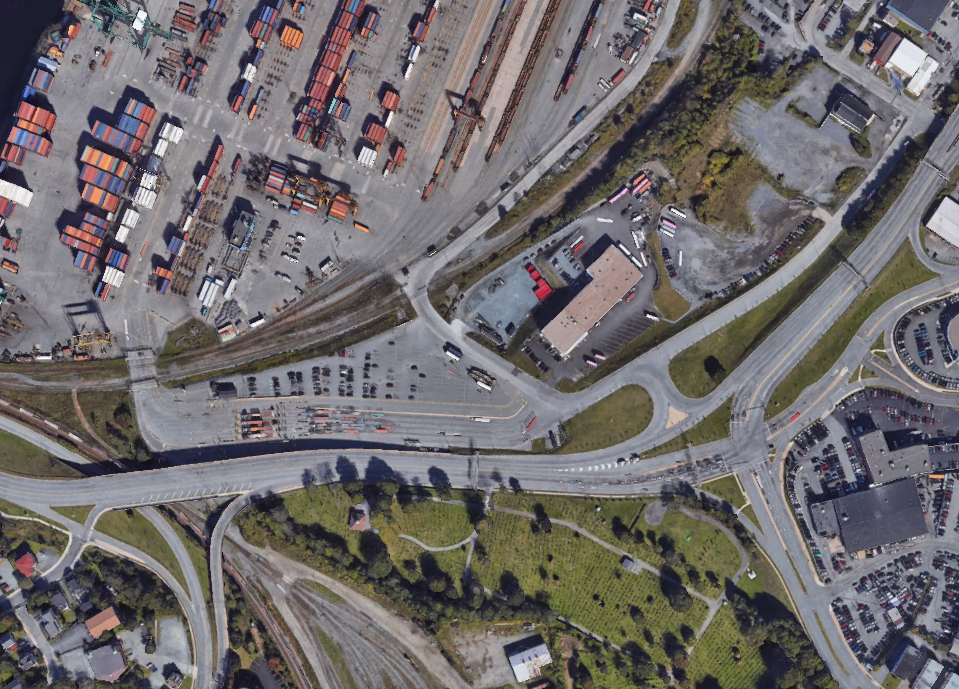IMTB Response to Phase 2 of the Winsdor Street Exchange Redevelopment Plan

Photo credits to Google Earth
This week, HRM was soliciting responses to Phase 2 of the Windsor Street Redevelopment Plan. IMTB responded with some very serious concerns about the plan’s lack of consideration for public transit that is fast, frequent, and reliable. In short, the plans to do not (at this point) guarantee that buses running through the newly developed Windsor Street Exchange won’t get stuck in private vehicle congestion. This is a serious problem that needs to be addressed in the next phase of planning. The Windsor Street Exchange will be a choke point that Halifax Transit’s proposed Bus Rapid Transit Green line runs through. But any bus that gets stuck in traffic is not Bus Rapid Transit.
The text of IMTB’s response to HRM follows below.
I am writing on behalf of It’s More Than Buses (IMTB) to offer feedback on Phase 2 of the Windsor Street Exchange (WSE) redevelopment project. IMTB has very serious concerns about both of the proposed design options. In both cases, our concerns are that the design options fail to adequately prioritize movement of public transit, and in particular, buses on the planned Bus Rapid Transit green line. However, Design Option B, amended to include robust transit priority measures, should be the preferred option.
Let me start by saying something about what Bus Rapid Transit is and why it is so important for HRM. Halifax Transit’s Bus Rapid Transit proposal is, by a very wide margin, the most important plan HRM has for dramatically shifting mode share from private vehicles to public transit. For that reason, making Bus Rapid Transit successful is absolutely essential if HRM is to have any hope of achieving its goals for modal split laid out in the Integrated Mobility Plan and the Regional Plan.
However, for Bus Rapid Transit to successfully induce large numbers of people to give up their private vehicles in favour of public transit, it must do three things.
- It must ensure that transit is fast, indeed, fast enough to make public transit travel times competitive with private vehicle travel times.
- It must ensure that transit is frequent, with buses arriving at each stop every ten minutes or faster.
- Finally, bus rapid transit must be reliable. That is, buses must arrive and depart stops within just a few minutes of their scheduled times.
The Phase 2 designs run the risk of making the Bus Rapid Transit green line fail on all three of these points, completely undermining the entire point of having Bus Rapid Transit running through the WSE. Here’s how.
As your presentation acknowledges, the WSE is one of only five road entrances on and off the Halifax Peninsula. For that reason, the WSE is always likely to be a choke point where private vehicle congestion prevents public transit from running fast and reliable schedules. As HRM adds residents over the coming decades, this problem will only get worse. Private vehicle congestion will have three serious consequences for the green line:
- Congestion will slow buses down, making their travel times wholly uncompetitive with private vehicle travel times;
- Congestion causes so-called “bus bunching.” That is, when buses are scheduled to have, for example, 10-minute headways between them, congestion often results in two or three buses running in a single bunch, with a 20- or 30-minute wait for the next bus that comes after the bunch passes. Congestion thus undermines the goal of running frequent transit.
- In exactly the same way, congestion makes it impossible for buses to stay on schedule, making them unreliable.
Design Option A provides no transit priority measures whatsoever through the WSE. Your projections suggest that even without those priority measures, travel times for transit are improved. That may be. However, will transit maintain its improved travel times through the WSE as HRM grows and the number of private vehicles driving through the WSE increases? As that number of private vehicles increases, the only way to maintain fast travel times for transit is with transit priority measures like queue jump lanes and signal priority. Because Design Option A does not allow for those priority measures, it is unacceptable.
Design Option B is somewhat better, since it allows for the possibility of keeping buses out of congestion with queue jump lanes and signal priority. However, it is a serious problem that those measures are not actually planned under Design Option B, but are considered merely possibilities for the future. Because the WSE is one of only five road entrances to the Halifax Peninsula, and thus is bound to be a choke point for private vehicle traffic, transit priority must be planned for it from the very beginning.
Finally, a last point on Design Option B. Your presentation claims that that option does not meet “AM and PM peak travel targets for all scenarios.” Without knowing exactly what those targets are or what “all scenarios” means, it is nevertheless important to stress that the IMP prioritizes public transit over private vehicle travel. If Design Option B, amended to include robust transit priority measures, increases public transit travel times at the expense of suboptimal private vehicle travel times, then it should be the preferred option. If Design Option B, amended to include transit priority measures, ensures that public transit will always run quickly and smoothly through the WSE, no matter how congested private vehicle traffic becomes, then it should be the preferred option.
Please do not hesitate to contact me about any of these matters.
Sincerely,
Scott Edgar,
Chair, It’s More Than Buses
